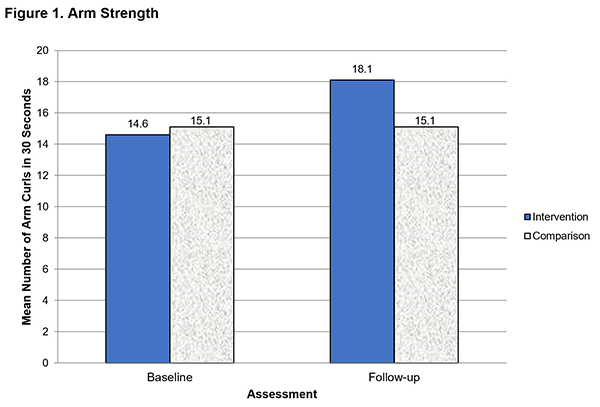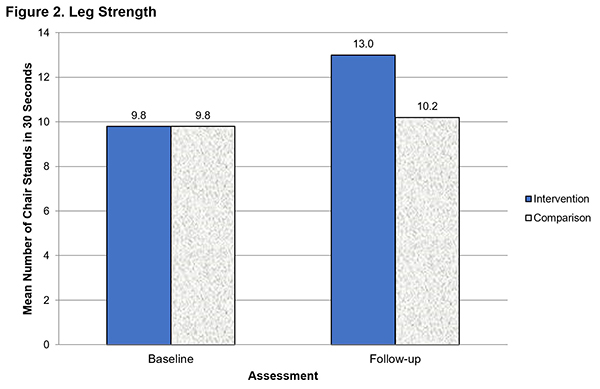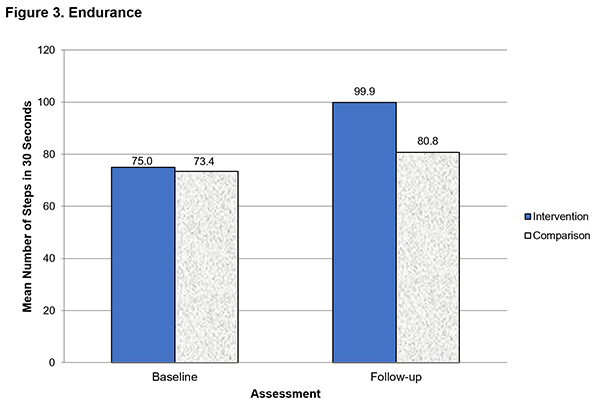Program Synopsis
Designed to help older adults increase physical activity, this community-based program provides three weekly, 1-hour classes over a 16-week period. The study showed improved arm strength, leg strength, and endurance.
Program Highlights
Program Materials
Preview and order the materials from the developer
Program Scores
The Need
Physical activity is important among older adults. Exercise can contribute to a healthy weight and reduce the risks of health-related conditions associated with overweight and obesity (e.g., heart disease, stroke, type 2 diabetes, certain types of cancer). Physical activity guidelines suggest that older adults aged 65 and older participate in aerobic, muscle-strengthening, and balance activities weekly to improve muscle strength and overall health. Programs are needed to help older adults meet these physical activity recommendations.
The Program
Enhance®Fitness is a community-based program that aims to increase physical activity among older adults through instructor-led exercise classes. The intervention components are as follows:
-- Instructor training: To become certified to lead Enhance®Fitness classes, instructors attend a 12-hour training in person or remotely that includes a live demonstration, role-playing exercises, and the use of audiovisual material.
-- Fitness classes: A certified instructor leads three in-person or live, remote classes per week. Classes are offered initially for 16 weeks but may continue longer. Each 1-hour class includes a warm-up, aerobic workout, cool-down, strength training, stretching, and balance exercises. Functional fitness tests are conducted when participants initially join the program and are repeated every 16 weeks thereafter to monitor progress. The classes also give participants a chance to socialize and meet new people.
Enhance®Fitness instructors should have a foundational fitness certification (e.g., personal training, group exercise) or a background in exercise science (e.g., occupational or physical therapy). They are also encouraged to have a current CPR certification.
Although the intervention currently includes three weekly classes over a 16-week period (and may continue longer), the study reviewed for this summary involved three weekly classes over a 12-week period. In addition, although the intervention was created for broad use with adults of all fitness levels, the study reviewed focused on sedentary older adults with arthritis.
Community Preventive Services Task Force Finding
 This program uses an intervention approach recommended by the Community Preventive Services Task Force: social support interventions in community settings (Physical Activity).
This program uses an intervention approach recommended by the Community Preventive Services Task Force: social support interventions in community settings (Physical Activity).
Time Required
-- 12 hours for instructors to complete the Enhance®Fitness instructor training
-- 48 hours for three weekly fitness classes over 16 weeks, more if additional classes are offered
Intended Audience
The intervention is intended for older adults.
Suitable Settings
The program is suitable for implementation in community settings.
Required Resources
Required resources to implement the program include the following:
-- Enhance®Fitness website
For costs associated with this program, click on Contact Program Developer on the Program Materials page.
About the Study
This quasi-experimental trial enrolled 17 community sites in four urban and five rural West Virginia counties. Eligible participants were sedentary adults (they self-reported 60 minutes or less of physical activity per week) who self-reported having physician-diagnosed arthritis.
Participants were recruited through a variety of methods (e.g., mail, email, door-to-door canvassing, newspaper and radio advertisements). Interested people were screened for eligibility by telephone. Participants underwent a baseline assessment and provided written informed consent. The first 134 participants were randomly assigned to the intervention group or a comparison group receiving the delayed intervention. Due to a lack of adequate participant availability, 189 additional participants were assigned to the two conditions without randomization. The exercise classes were delivered in person.
The study enrolled 323 participants. The majority of participants were women (86%), and 95% were White. The average age was 68.3 years. The sample had a high prevalence of chronic conditions (e.g., disability, obesity). Relative to the comparison group, the intervention group had a higher proportion of people living in a rural area, a lower proportion of people having a disability that required special equipment, and a lower mean body mass index.
The primary outcomes were arm strength, leg strength, and endurance. Using the arm curl test, arm strength was measured by the number of times participants bent and straightened their elbow in 30 seconds while gripping a 5-pound weight (women) or 8-pound weight (men). Using the chair stand test, leg strength was measured by the number of times participants stood up and down from a chair in 30 seconds. Using the 2-minute step test, endurance was measured by the number of steps participants took while walking in place for 2 minutes. Outcomes were assessed at baseline and 12-week follow-up.
Secondary outcomes were functional mobility and arthritis symptoms. Using the 8-foot up-and-go test, functional mobility was measured by the time it took participants to stand, walk 8 feet, turn, walk back, turn, and sit down. Arthritis symptoms were measured through a self-report survey. Participants were asked to report their past-week pain intensity, stiffness, and fatigue using 10-centimeter Visual Analogue Scales (VAS), with scores ranging from zero (no symptoms) to 10 (worst ever).
Key Findings

-
From baseline to 12-week follow-up, the number of arm curls increased in the intervention group and remained the same in the comparison group (p<.001).

-
From baseline to 12-week follow-up, the intervention group had a greater increase than the comparison group in the number of chair stands completed (p<.001).

-
From baseline to 12-week follow-up, the intervention group had a greater increase than the comparison group in the number of steps completed (p<.001).
Additional Findings
-
From baseline to 12-week follow-up, the intervention group had a greater decrease than the comparison group in the time required to complete the 8-foot up-and-go test (functional mobility, p<.001).
-
From baseline to 12-week follow-up, the intervention group had a greater decrease than the comparison group in arthritis symptoms (pain intensity, p<.01; stiffness, p<.001; fatigue, p=.02).


